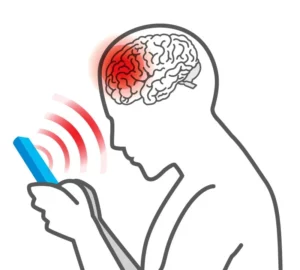Imagine a time when smoking was not only a common habit but also widely endorsed by the medical community. Cigarette advertisements often featured doctors, confidently assuring the public that smoking was safe, even beneficial. Fast forward a few decades, and we now recognize the catastrophic health impacts of smoking, with lung cancer being just one of the many diseases linked to tobacco use. This shift in understanding took years, with early warnings ignored and the scientific community slow to catch up. Today, a similar scenario might be unfolding with electromagnetic fields (EMFs).
EMFs are an inescapable part of modern life, emitted by everything from cell phones and Wi-Fi routers to power lines. Yet, despite their sudden ubiquity, the potential health risks associated with prolonged EMF exposure remain a topic of intense debate and uncertainty. Just as it took decades for the dangers of smoking to be acknowledged and acted upon, the true impact of EMFs on our health may not be fully understood or publicly recognized for many years.
In this blog, we will look at the eerie parallels between the history of cigarette use and the current state of EMF exposure. We’ll examine how the slow pace of scientific research and the cautious stance of public health recommendations can leave us vulnerable. By learning from the past, we can better navigate the potential risks of our increasingly wireless world and advocate for a more proactive approach to public health.

Historical Parallel – Cigarettes and Lung Cancer
In the early 20th century, smoking was not just a common habit; it was a symbol of sophistication and modernity. Cigarette advertisements often portrayed smoking as glamorous and healthful, with doctors and celebrities endorsing various brands. This widespread social acceptance created an environment where the potential dangers of smoking were not just overlooked — they were actively denied.
Medical Community’s Initial Stance
During this period, the medical community lacked awareness and understanding of the health risks associated with smoking. Despite emerging evidence suggesting a link between smoking and lung diseases, these early warnings were largely ignored or dismissed. Anecdotal evidence and preliminary studies indicating potential harm

were overshadowed by the prevailing belief that cigarettes were harmless and, of course, financial incentives.
The Shift in Perception
The turning point came with landmark studies in the mid-20th century that provided irrefutable evidence linking smoking to lung cancer and other serious health issues. As the body of scientific evidence grew, public health campaigns began to shift the narrative. Regulatory changes followed, leading to warning labels on cigarette packages, advertising restrictions, and comprehensive public health campaigns aimed at reducing smoking rates.
The journey from widespread acceptance to recognition of the dangers of smoking was long and filled with resistance. This historical context serves as a powerful reminder of how slow the process of scientific discovery and public health recommendation can be, and the significant impact it has on public well-being.
What are EMFs

Electromagnetic fields (EMFs) are invisible areas of energy, often referred to as radiation, that are associated with the use of electrical power and various forms of natural and man-made lighting. EMFs can be broadly categorized into two types: ionizing and non-ionizing radiation. Ionizing radiation, such as X-rays and gamma rays, has enough energy to remove tightly bound electrons from atoms, thus creating ions. Non-ionizing radiation, which includes EMFs from cell phones, Wi-Fi routers, and power lines, has less energy and has been largely dismissed as being less harmful, though its effects are still under investigation.
Most Common Sources of Exposure
In today’s tech-centered world, EMFs are omnipresent. We are constantly surrounded by devices and infrastructure that emit these fields. Common sources include:
- Cell Phones and Smartphones: Emitting radiofrequency EMFs when making calls, sending texts, or using data.
- Wi-Fi Routers: Creating a network of radiofrequency EMFs to enable wireless internet connectivity.
- Power Lines: Generating low-frequency EMFs as electricity is transmitted from power plants to homes and businesses.
- Household Appliances: Everyday devices like microwaves, televisions, and even hairdryers emit varying levels of EMFs.
With the proliferation of technology, our exposure to EMFs has increased exponentially. From wearable tech to smart home devices, the modern lifestyle is heavily intertwined with EMF-emitting devices. While these advancements offer convenience and connectivity, they also raise questions and serious concerns about long-term health impacts.
Emerging Concerns About EMFs
As our reliance on EMF-emitting devices grows, so does the body of research examining their potential health impacts. Numerous studies have explored the links between EMF exposure and various health issues, including:
- Cancer: Some studies suggest a potential link between prolonged EMF exposure and an increased risk of certain types of cancer, such as brain tumors. However, these findings remain controversial, with many studies providing inconclusive or conflicting results.
- Neurological Effects: Research has indicated that EMF exposure might impact brain activity, sleep patterns, and cognitive functions. There are concerns that long-term exposure, particularly in children, could affect brain development and function.
- Reproductive Health: Studies have suggested possible effects on fertility and reproductive health, with some evidence indicating that EMF exposure might affect sperm quality and, in turn, pregnancy outcomes.
Despite these findings, the scientific community remains divided. Many studies have methodological limitations, and the variability in results makes it challenging to draw definitive conclusions. The complexity of EMF exposure, involving different frequencies, intensities, and durations, all add to the difficulty of establishing clear causal relationships.
Comparing to Early Cigarette Research
The current state of EMF research bears striking similarities to the early days of cigarette research. Initially, studies linking smoking to lung cancer faced skepticism and resistance. The tobacco industry’s influence and the slow pace of accumulating robust evidence contributed to prolonged public uncertainty and delayed health warnings.
Similarly, EMF research is navigating a landscape of skepticism, competing interests, and the inherent challenge of proving long-term health impacts. The precautionary principle, which advocates for preventive action in the face of uncertainty, is often overshadowed by the demand for conclusive proof. This mirrors the early attitudes towards smoking, where the lack of immediate, overwhelming evidence allowed harmful practices to persist.
The slow accumulation of evidence and the difficulty in establishing causation mean that, much like with cigarettes, it may be years before the true health impacts of EMF exposure are fully understood. This delay in scientific consensus and public health action poses significant risks, emphasizing the need for vigilance and precaution in our approach to modern technology.
The Lag Between Science and Public Recommendations
One of the key challenges in public health is the time it takes for scientific research to translate into public health recommendations. The process of gathering robust evidence, undergoing peer review, and reaching a consensus can span multiple decades. This lag was evident in the case of cigarettes, where early warnings about the dangers of smoking were ignored for years due to the lack of conclusive evidence and the powerful influence of the tobacco industry.
In the context of EMFs, we see a similar slow pace of scientific consensus. Despite growing concerns and preliminary studies suggesting potential health risks, the evidence is often deemed insufficient to prompt immediate public health action. The variability in study designs, exposure measurements, and health outcomes further complicates the process of establishing clear guidelines.
Consequences of Bureaucratic Delay
The delayed recognition of the dangers of smoking had devastating consequences. Millions of people suffered from lung cancer, heart disease, and other smoking-related illnesses while the scientific community and public health authorities grappled with conflicting evidence and industry pushback. This historical lesson highlights the human cost of waiting for definitive proof and “official recommendations” before taking preventive action.
Similarly, the potential health risks associated with prolonged EMF exposure might not be fully acknowledged until many individuals have suffered many years of lost vitality. Without timely and precautionary measures, people may continue to suffer from avoidable health issues. The current cautious stance, reminiscent of the early days of cigarette research, leaves the public vulnerable to possible risks that could have been mitigated with earlier intervention.
Learning from the Past
The history of cigarettes teaches us the importance of proactive public health measures, even in the face of scientific uncertainty. Applying the precautionary principle — taking preventive action in the presence of potential risks without waiting for conclusive evidence — can help protect public health. In the case of EMFs, this might involve:
- Raising Awareness: Educating the public about the potential risks associated with EMF exposure and ways to minimize it.

Save 25% on all Aires Tech Lifetune Devices with code “PRIME” - Encouraging Further Research: Supporting independent studies to better understand the health impacts of EMFs.
- Implementing Precautionary Measures: Advising the public on practical steps to reduce EMF exposure, such as using wired connections, limiting cell phone use, keeping electronic devices away from sleeping areas, and using EMF protection like Aires Tech (what we use and the only one that has legitimate science to back its efficacy) to mitigate the effects of excessive exposure.
By learning from the past and applying these lessons to the present, we can better navigate the uncertainties surrounding EMFs and safeguard our health in the years to come.
Closing Thoughts
Reflecting on the history of cigarettes and the slow recognition of their dangers, we see a cautionary tale for our current approach to EMFs. The delayed response to early warnings about smoking resulted in widespread suffering and preventable illnesses. Today, we face a similar scenario with EMFs, where the science is still catching up, and public health recommendations are cautious.
If we are to learn from our past, we have to advocate for a more proactive approach to EMF exposure. By raising awareness, supporting research, and taking personal precautions, we can protect our health and that of future generations. It may be years before science provides definitive answers, but in the meantime, we have the power to act now and reduce potential risks.
The lesson from cigarettes is clear: waiting for conclusive proof and “official recommendations” from bureaucratic institutions can come at a high cost. Embracing the precautionary principle and taking preventive action today can help mitigate potential risks associated with EMF exposure. As we continue to navigate the uncertainties of modern technology, let’s prioritize our health and well-being, and do our best to ensure a safe and healthy future for all.










